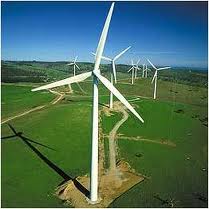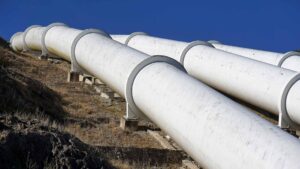A landmark study by Fiona Crichton at the University of Auckland recently showed that propaganda linking the low levels of noise from wind to sickness is a strong cause of anxiety related symptoms. The control group, which hadn’t watched the video of health fears from anti-wind campaigners, had no symptoms.
The findings backed up previous reports in Australia showing “unwarranted fear-mongering might cause greater health impacts than the presence of any actual ‘Wind Turbine Syndrome’”.
Sarah Laurie, head of the Waubra Foundation, an offshoot of the anti-wind, astroturfer, the Landscape Guardians, is the source of a great deal of the anti-wind propaganda which is harming people’s health.
To date, Sarah Laurie’s work has been largely constrained to south-eastern Australia, however she has begun to spread her wings. We can expect a related spread of so-called ‘Wind Turbine Syndrome’, an illness that Professor Simon Chapman has famously dubbed a ‘communicated disease’. (Due to her active spreading of disinformation, she’s up for the Australian Skeptics’ annual Bent Spoon award for 2013.)
On 20 March, Ms Laurie appeared as a guest of Bill Padley on Let’s Talk on Talk Radio Europe (full transcript here) which was founded to provide the sounds of home to people from England properties on Spain’s coastline. Other guests have included well-known climate change denialists including James Delingpole and Bjorn Lomborg. For context, Spain has had one of the most ambitious and successful campaigns to implement wind energy in Europe.
Obviously, Ms Laurie has a much more sympathetic audience than during her experience under oath in the Environment, Resources and Development (ERD) Court in South Australia in 2011. So what does she say?
Quote 1: Ms Laurie invents a diaspora
‘…people are literally being driven out of their homes because of the acoustic pollution.’
Ms Laurie makes this claim regularly, but when pressed refuses to provide more than one or two examples. One is Noel Dean, who claims that his pocket phone miraculously charges when he is close to wind turbines and that the “frequencies produced by the turbines are the same as those that operate the brain” in a recent Senate submission. There are about 240,000 wind turbines operating worldwide, yet only a handful of similarly dubious examples are cited.
Quote 2: Ms Laurie keeps losing parts of the sound spectrum to blame
‘…most of the noise regulations only actually measure the audible part of the sound spectrum above 200 Hz so the regulations don’t actually measure the sound frequencies we believe are causing the problems.’
Numerous studies have measured the lower frequency sounds Ms Laurie claims are a problem. Most recently, the South Australian Environmental Protection Authority (EPA) published a study that measured down to 0.25 Hz and found that the homes nearest wind farms actually had the least low frequency and infrasound of any building studied.
The EPA also tested for low-frequency noise at homes near wind farms with so called ‘on/off testing’. Inconveniently for Ms Laurie, there was no discernible difference when the turbines were switched on and off. These results are in line with a number of other studies which show that urban dwellers are constantly exposed to much higher levels of low-frequency and infrasound than the levels supposedly causing problems for those near wind farms.
Ms Laurie incorrectly claimed the South Australian EPA report only measured down to 10 Hz during an Australian radio interview. Time and again, anti-wind campaigners such as Ms Laurie conjure up scary theories that might sound plausible to the non-scientific community, then get forced off of that patch of land into even swampier terrain. Not long ago, anti-wind campaigners were arguing that ultrasound from wind turbines was causing sickness. Perhaps she’ll be blaming negative frequencies soon?
Quote 3: Ms Laurie misremembers sick building syndrome
BP: We had something called sick building syndrome […] discovered to be misaligned air conditioning systems.
SL: Physiologically we believe it is identical, it’s just low-frequency noise from another source.
The actual cause of sick building syndrome was poor indoor air quality.
Quote 4: Ms Laurie complains that people see the Waubra Foundation for the fraud it is
‘…we are frequently misrepresented in the media of being anti-wind.’
Since the Waubra Foundation was registered three years ago, it has relentlessly attacked wind energy. Her organisation takes its name from Waubra, an Australian town with a wind farm — yet none of its six directors live within 120 kilometers of the town – a fact that outrages the local community, which objects to the town’s name being hijacked for a political and science-free agenda.
Five of the Foundation’s directors are on record as objectors to wind farms in their own back yards. The organisation is chaired and run predominantly by the anti-wind lobby group the Australian Landscape Guardians. Ms Laurie herself has admitted under oath that she became active shortly after a wind farm was proposed near her home.
Until recently, the Waubra Foundation shared a P.O. box with the Landscape Guardians and a mining investment company. This is not surprising given that all were founded by Peter Mitchell, a lifelong fossil fuel executive and investor. After taking considerable heat for its address, the foundation has now relocated its mailing address to a P.O. box just around the corner from its secretary’s home in leafy Melbourne suburbia. That secretary is Mr Mitchell’s long-time assistant.
Laurie frequently appears as an invited guest on right-wing shock-jock radio programs, comments at length on rabid anti-wind blogs, closely associates with the few anti-wind politicians and gives keynote addresses at anti-wind rallies.
Despite the overwhelming evidence that the Waubra Foundation is solely an anti-wind power organisation, created and maintained for that purpose, and that Ms Laurie as its primary mouthpiece and has been fomenting anti-wind sentiment in Australia and now world-wide for three years, Ms Laurie frequently claims that she, and the Foundation she heads, aren’t against wind energy.
Quote 5: Ms Laurie plays the persecution card
‘I’m certainly aware of a systematic campaign to denigrate and vilify sick people who speak up and say that they are unwell and the same is occurring for professionals who advocate on their behalf.’
This is another piece of paranoid conspiracy ideation that Ms Laurie and other anti-wind campaigners trot out. What they call denigration looks to an objective observer like disagreeing with a dangerously inaccurate self-diagnoses. When objective public health professionals such as Dr David Colby and Dr Arlene King of Canada lead teams of dedicated, experienced professionals in assessing wind energy and find that there is no evidence that wind farms cause health problems, anti-wind campaigners attack and vilify them. There have been 17 reviews worldwide clearing wind energy of health impacts.
Anti-wind campaigners such as Ms Laurie have recently been stating that Professor Chapman’s and Ms Crichton’s studies, referenced above, denigrate sick people. In fact they take health complaints at face value and ask a question that anti-wind campaigners refuse to ask: what is the most likely cause of these complaints?
Quote 6: Ms Laurie is tone deaf regarding the acoustics profession
‘…it’s certainly provoking a crisis amongst the acoustics profession […] there is some evidence that there are acousticians who are being economical with the truth.’
The crisis is what to do with a rogue acoustician named Steven Cooper who is accusing Australian acousticians of being unethical, and then making claims to be representing acousticians in anti-wind statements. Here is what the Australian Acoustical Society had to say to an Australian Senate hearing in 2012:
With regard to the witness submissions made to the Committee on the above Bill, the Council of the Australian Acoustical Society (AAS) wishes it known that the Australian Acoustical Society neither supports nor endorses Mr Cooper’s statements made to the committee.
[…]
Under no circumstance can Steven Cooper claim that his article in the August 2012 issue of the Acoustics Australia journal was peer-reviewed by the editor or for publication in the journal by the journal.
The acoustician being economical with the truth is Ms Laurie’s favourite. For an example of Mr Cooper’s inability to distinguish between harmless, inaudible background infrasound and sound signature from a turbine 8 kilometres away, see Quote 11 in Barnard on Wind.
Quote 7: Ms Laurie isn’t convinced that global warming is real, and doesn’t believe that wind turbines reduce green house gases
‘There’s certainly some work that’s been done in the Netherlands, the US and in Australia that suggest there is no reduction of greenhouse gas emissions, quite apart from the debate that exists about climate change.’
There isn’t a debate about whether climate change is occurring, that it is serious or whether humanity’s emissions of CO2e are the primary cause.
As for wind farms, the words of the Director of Energy Strategy for the UK’s National Grid makes it clear based on their studies, as do all other credible studies, that each MWh of wind power eliminates 99.9 per cent of the CO2e that would have been produced by fossil fuel generation.
Quote 8: Will the real Sarah Laurie please stand up?
BP: You were appearing under oath before the Environment Resources and Development Court in South Australia and you said you didn’t think it was realistic to put yourself forward as an expert witness.
SL: I’m a lot more knowledgeable now.
Here’s what Ms Laurie stated under oath.
- “I also didn’t feel it was realistic to put myself forward as an expert witness.”
- “I am not an endocrinologist.”
- Q. “In the next paragraph Professor Wittert says he‘s been engaged as an independent medical expert on the basis of his broad understanding of human health and understanding of ecological methods.’ Do you claim expertise in those areas.”
“No, I don’t…” - “I am not an academic. I don’t do it [review research papers and results] for a living. When I looked at this data I didn‘t do the sophisticated analysis, I don’t have access to that sort of programing that Professor Wittert says…”
- “I’m not an acoustician….”
Ms Laurie is also not an expert in psychology, the psychology of health or other areas that overlap with the nocebo effect and its impacts. She has also agreed that she has absolutely no background that prepared her to do medical research.
None of this has changed in the months since she testified.
Quote 9: Ms Laurie’s grasp of the severity of real medical concerns is troublingly non-existent
‘I think there is enough precedents in terms of thalidomide, asbestos, tobacco, there’s plenty of examples where industry has been very reluctant to admit things that it subsequently proved later that they knew all along.’
Professor Chapman’s research has shown that less than 1 in 272 people living near Australian wind farms have ever filed a complaint. Ms Laurie — a former family doctor without research qualifications who has been unregistered and non-practicing longer than she was practicing — derives her evidence from the anecdotal and non-verifiable self-diagnosis of a tiny number of complainants and draws scientifically and medically implausible (and often untestable) conclusions.
Compare this with the history of thalidomide, asbestos and tobacco. In each one of those cases there was a long history of clear harm, diagnosed by medical doctors, proven in research, demonstrated in court cases and written up in the literature over and over.
The worst that the credible research on wind power shows is that some people find the sounds produced by wind farms annoying.
Quote 10: Ms Laurie mistakes competitive threat clauses for gag clauses
‘…in Australia and the US and in Canada and, I’m not sure about the UK, but in those three countries I’m well aware of the practice of having contracts where there are confidentiality clauses so if the turbine hosts get sick, if there’s a confidentiality clause they can’t speak publicly.’
The so-called gag clauses have turned out to be in early leasing contracts. They have standard contractual language that prevents landowners from informing competitive wind energy companies that they have entered into an agreement. These aren’t health-related clauses. Wind energy companies have repeatedly advised that these clauses do not constrain individuals from making any form of health complaint, in fact it would be impossible to contract someone out of this basic right.
Quote 11: Ms Laurie mistakes wind farms for fossil fuels when it comes to bird deaths
BP: Every turbine kills an average of 300 birds a year — often rare birds like eagles.
SL: Look, I think that’s very disturbing and I think the suppression of that, or the historic suspicion of that sort of information and denial is absolutely appalling.
Wind farms average 1-2 bird deaths per turbine per year around the world. Every study, every energy utility and every major birding organization in the world agrees that wind energy is one of the absolute best choices for birds and wildlife in general.
The research Mr Padley is talking about took the absolute worst outlier wind turbine in the highest migration season of the biggest migration year and pretended that was the average for all wind turbines everywhere for all time. Ms Laurie not only accepted that at face value, but leapt to the assumption that it was being suppressed in some bizarre conspiracy.
Summary:
Ms Laurie fit in over 2,000 words into her 15 minutes of airtime. And, in those words, she managed to get almost everything she said provably wrong and malign a broad range of professional and highly credentialled people. This is an amazing amount of disinformation, and this is what she does every chance she gets.
While this might seem just part of battle of words in an ideological war, it is much more serious than that — Crichton’s research indicates that such wind energy disinformation spread by anti-wind campaigners like Sarah Laurie is significantly responsible for the anxiety affecting the very people that it is intended to help. Sadly, there are reports of people being affected by wind turbines before they are even constructed.
A version of this story was first published in Independent Australia on 9 April 2013, reproduced with permission. An earlier version appeared in Mike Barnard’s blog Barnard on Wind
Read the investigation that made it to Parliament on the web of vested interests behind the Waubra Foundation and the Landscape Guardians in Sandi Keane’s The Ugly Landscape of the Guardians









